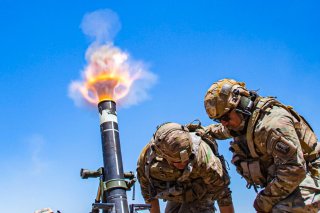Optimizing the Human Weapon System: How the Army Is Building Better Soldiers
This project at Army Futures Command uses sensors to measure and assist combat performance, training, and recovery.
When facing an enemy attack, a soldier's heart rate rushes up, breathing intensifies, and cognition accelerates. While this reaction may seem obvious, it also has tactical implications.
Perhaps an infantry soldier maneuvers quickly, jumps, ducks for cover, or runs to contact to close with an enemy? There may be elements of physical fatigue. If a soldier has not rested in several days, his or her performance, concentration, and speed might be impaired.
Not only are these variables relevant to combat, but they are also increasingly measurable. While stress can generate a wide range of physiological reactions, one lesser-recognized reality is that it might actually improve performance, according to Army scientists now researching and experimenting with ways to measure and analyze physiological nuances.
While under stress, a soldier may become more vigilant and operate with must sharper, faster focus. Fear, anxiety and a jumping heart rate can streamline or even sharpen senses to some extent, making a soldier a bit quicker, precise or more reactive.
“Stress is not always bad. Complacency gets us hurt,” said Joseph E. Patterson in an interview with the National Interest. Patterson is Soldier Performance Strategist Optimizing the Human Weapon System (OHWS) Project Lead at the DEVCOM Soldier Center at Army Futures Command.
The OHWS research is focused on measuring and analyzing human physiological and psychological variables with a mind to taking care of soldiers and optimizing combat performance.
“The human being is the most important capability we have on the battlefield,” Patterson said. “We can use stress to our advantage.”
The program is a research and development effort with DEVCOM, the Army Soldier Center within Army Futures Command. Its focus is adding context and analysis to physiological markers and understanding human performance data. The goal, Patterson explained, is to optimize the human weapons systems.
Using body sensors such as watches to monitor heart rate and other dual-use technologies, the OHWS program seeks to assist actual combat performance and streamline training. For example, the sensors can measure the impact of sleep deprivation and assess the operational impact of anxiety, sadness, or soldier depression. By comparing physiological markers from worn sensors, Army health professionals can conduct interviews with soldiers to merge the data with more subjective variables such as mood or feeling to create an integrated picture with which to make decisions or inform commanders.
“What we have seen, for instance, is a mood change four days prior to disruption of sleep. Sleep disruption can be an indicator of stress,” Patterson said. “Sleep is foundational as a variable which impacts cognitive performance.”
There are also medical applications, such as the ability to locate early phases of a sickness. Sensors may be able to find early signs of the flu, infection, or even Covid-19.
Kris Osborn is the defense editor for the National Interest. Osborn previously served at the Pentagon as a Highly Qualified Expert with the Office of the Assistant Secretary of the Army—Acquisition, Logistics & Technology. Osborn has also worked as an anchor and on-air military specialist at national TV networks. He has appeared as a guest military expert on Fox News, MSNBC, The Military Channel, and The History Channel. He also has a Master’s Degree in Comparative Literature from Columbia University.
Image: Reuters.

